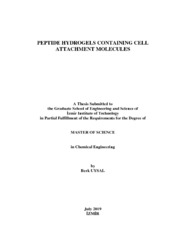Please use this identifier to cite or link to this item:
https://hdl.handle.net/11147/7453Full metadata record
| DC Field | Value | Language |
|---|---|---|
| dc.contributor.advisor | Top, Ayben | - |
| dc.contributor.author | Uysal, Berk | - |
| dc.date.accessioned | 2019-12-10T13:40:02Z | |
| dc.date.available | 2019-12-10T13:40:02Z | |
| dc.date.issued | 2019-07 | - |
| dc.identifier.citation | Uysal, B. (2019). Peptide hydrogels containing cell attachment molecules. Unpublished master's thesis, İzmir Institute of Technology, İzmir, Turkey | en_US |
| dc.identifier.uri | https://hdl.handle.net/11147/7453 | - |
| dc.description | Thesis (Master)--Izmir Institute of Technology, Chemical Engineering, Izmir, 2019 | en_US |
| dc.description | Includes bibliographical references (leaves: 40-50) | en_US |
| dc.description | Text in English; Abstract: Turkish and English | en_US |
| dc.description.abstract | In this study, peptides with sequences and notations as KLELKLELKLEL (KLEL), KLDVKLDVKLDV (KLDV), KLDVKLDVKLKV (KLKV1), KLKVKLDVKLKV (KLKV2), KLKVKLKVKLKV (KLKV3) were synthesized using solid phase peptide synthesis (SPPS) method based on Fmoc chemistry. Reverse phase HPLC and MALDI-TOF mass spectroscopy characterization methods were used to assess the purity of the peptides. Three different synthesis procedures were tested, and it was found that employing DMF:DMSO at 1:1 ratio as a solvent increased purity of the resultant peptide. FTIR results indicated the presence of expected β-sheet secondary structure, as well as an interference band from TFA salts for all of the peptides. All the peptides formed hydrogels at pH 7.4 with 1 wt% concentration in deionized water (DIW). AFM results of these hydrogels indicated that KLKV1 and KLKV2 had fibrous morphology with a width of 5-20 nm and 7-18 nm respectively. KLDV and KLKV3 peptide hydrogels, on the other hand, exhibited globular structures, having sizes with 15-50 nm and 8-15 nm, respectively. Storage moduli (G’) of these hydrogels in DIW were obtained as ~860 ± 150 Pa, ~260 ± 60 Pa, ~210 ± 30 Pa and ~1850 ± 200 Pa for KLDV, KLKV1, KLKV2 and KLKV3 respectively. Of these peptides, only HCl salt of KLDV and KLKV1 peptides more readily formed hydrogels in PBS but at 1.5 wt% concentration. G’ values of these KLDV and KLKV1 hydrogels were determined as ~1810 ± 850 Pa and ~700 ± 230 Pa, respectively. Cell proliferation tests (CCK-8 assay) of KLDV and KLKV1 hydrogels were performed by using L929 mouse fibroblast cells. Empty wells (TCPS) were used as a control group. Cell proliferation was observed to be comparable for both select hydrogels and empty wells, suggesting possible applications of these hydrogels in tissue engineering. | en_US |
| dc.description.abstract | Bu çalışmada KLELKLELKLEL (KLEL), KLDVKLDVKLDV (KLDV), KLDVKLDVKLKV (KLKV1), KLKVKLDVKLKV (KLKV2), KLKVKLKVKLKV (KLKV3) dizinleri ve kısaltmalarına sahip peptidler, f-moc kimyası temelli katı faz peptid sentez yöntemi (SPPS) kullanılarak sentezlenmiştir. Peptidlerin saflığını değerlendirmek için ters faz HPLC ve MALDI-TOF kütle spektroskopisi karakterizasyon yöntemleri kullanılmıştır. 3 farklı sentez prosedürü test edilmiştir ve çözgen olarak 1:1 oranda DMF:DMSO kullanılmasının, elde edilen peptidin saflığını artırdığı bulunmuştur. FTIR sonuçları, tüm peptidler için beklenen β-sheet ikincil yapısıyla birlikte, TFA tuzlarından gelen girişim bandını göstermiştir. Bütün peptidler, ağırlıkça 1% derişim, pH 7.4 ve deiyonize su içerisinde hidrojel oluşturmuştur. Bu hidrojellerin AFM sonuçları, KLKV1 ve KLKV2’nin, sırasıyla 5-20 nm ve 7-18 nm genişlikte lifli morfolojiye sahip olduğunu göstermiştir. Diğer taraftan, KLDV ve KLKV3 peptid hidrojelleri, sırasıyla, 15-50 nm ve 8-15 nm boyutları arasında küresel yapılar sergilemiştir. Deiyonize suda hazırlanan bu hidrojellerin, saklama modülleri, KLDV, KLKV1, KLKV2 ve KLKV3 için, sırasıyla, ~860 ± 150 Pa, ~260 ± 60 Pa, ~210 ± 30 Pa ve ~1850 ± 200 Pa olarak elde edilmiştir. Bu peptidlerden, sadece KLDV ve KLKV1 peptidlerinin HCl tuzları, PBS içerisinde, ağırlıkça 1.5% derişimde hidrojel oluşturmuştur. Bu KLDV ve KLKV1 hidrojellerinin G’ değerleri, sırasıyla ~1810 ± 850 Pa ve ~700 ± 230 Pa olarak belirlenmiştir. KLDV ve KLKV1 hidrojellerinin hücre çoğalma testleri (CCK-8 analizi) L929 fare fibroblast hücreleri kullanılarak yapılmıştır. Boş kuyucuklar (TCPS) control grubu olarak kullanılmıştır. Her iki seçilmiş hidrojel ve boş kuyucuklar için hücre çoğalması karşılaştırabilir olarak gözlenmiş ve sonuç olarak bu hidrojellerin doku mühendisliğinde muhtemel uygulamaları olabileceğini önermektedir. | en_US |
| dc.format.extent | ix, 50 leaves | - |
| dc.language.iso | en | en_US |
| dc.publisher | Izmir Institute of Technology | en_US |
| dc.rights | info:eu-repo/semantics/openAccess | en_US |
| dc.subject | Hydrogel | en_US |
| dc.subject | Peptides | en_US |
| dc.subject | Biological cues | en_US |
| dc.subject | Peptide based hydrogels | en_US |
| dc.title | Peptide Hydrogels Containing Cell Attachment Molecules | en_US |
| dc.title.alternative | Hücre Yapışma Molekülleri İçeren Peptid Hidrojeller | en_US |
| dc.type | Master Thesis | en_US |
| dc.institutionauthor | Uysal, Berk | - |
| dc.department | Thesis (Master)--İzmir Institute of Technology, Chemical Engineering | en_US |
| dc.relation.publicationcategory | Tez | en_US |
| dc.identifier.wosquality | N/A | - |
| dc.identifier.scopusquality | N/A | - |
| item.openairecristype | http://purl.org/coar/resource_type/c_18cf | - |
| item.languageiso639-1 | en | - |
| item.openairetype | Master Thesis | - |
| item.grantfulltext | open | - |
| item.fulltext | With Fulltext | - |
| item.cerifentitytype | Publications | - |
| Appears in Collections: | Master Degree / Yüksek Lisans Tezleri | |
Files in This Item:
| File | Description | Size | Format | |
|---|---|---|---|---|
| T001908.pdf | MasterThesis | 1.53 MB | Adobe PDF |  View/Open |
CORE Recommender
Page view(s)
340
checked on Mar 31, 2025
Download(s)
362
checked on Mar 31, 2025
Google ScholarTM
Check
Items in GCRIS Repository are protected by copyright, with all rights reserved, unless otherwise indicated.